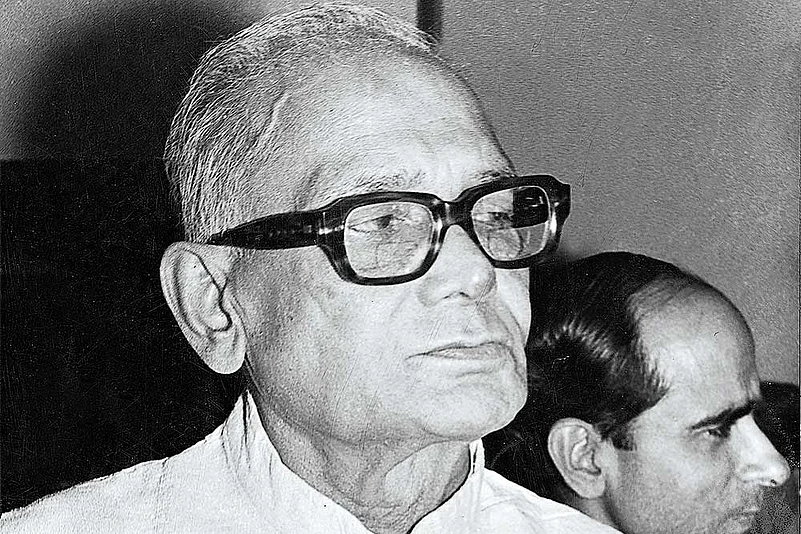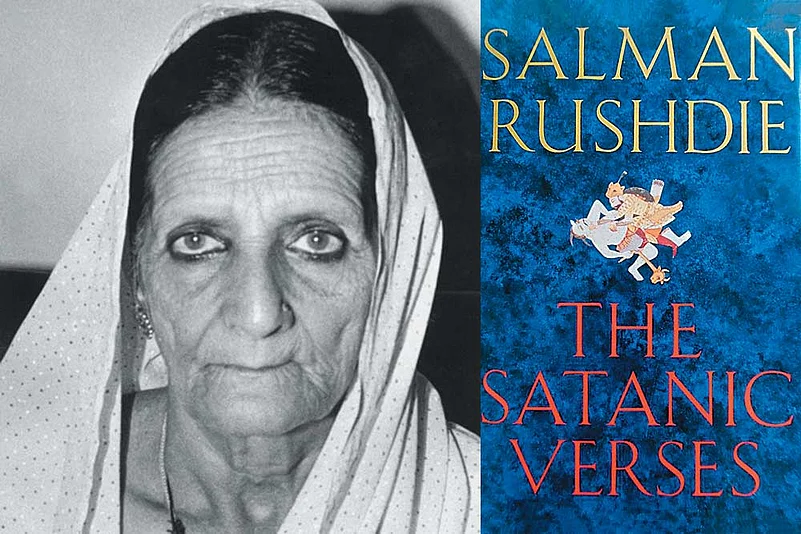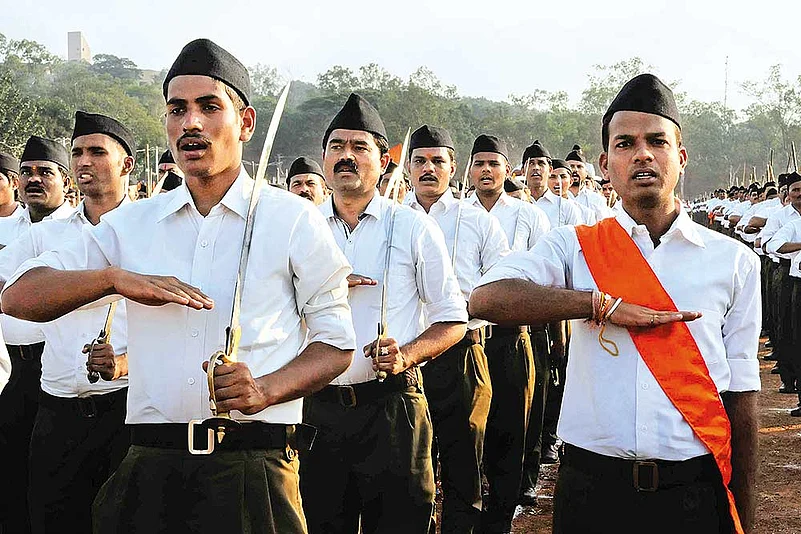In May 2104, Narendra Modi spoke with misty eyes to all the MPs of his party, and what the new prime minister said brought tears to many in the gathering. Modi began his triumphant address by expressing gratitude to “five generations of dedicated workers, whose sacrifice made this glorious victory possible”.
He was referring to cadres of the RSS which, since its inception in 1925, through its numerous subsidiary organisations including BJP and its previous avatar Bharatiya Jana Sangh, has been working towards a “cultural” goal. All organisations work like members of a ‘family’ towards this shared goal, with the RSS in the role of the patriarch, guiding and supervising their activities. The RSS insists on calling itself a cultural organisation, claiming to have no interest in ‘politics’. It is another matter that BJP leaders and workers, by their own admission, are nurtured in the RSS ‘nursery’. Also, the person in charge of BJP organisation (Sangathan Mantri) is invariably a senior RSS functionary on deputation to the BJP. As a matter of fact, the RSS was forced to formally adopt a ‘non-political’ stance under pressure from Sardar Patel, who made it a pre-condition to lifting a ban imposed on the Sangh in the wake of the murder of Mahatma Gandhi.
In RSS discourse, ‘political’ means only the everyday parliamentary and extra-parliamentary processes, while the ‘cultural’ signifies a comprehensive agenda of creating a controlled space for the exercise of political options. Culture, to the RSS, is a not a vibrant space of creative expression or interrogation of shared experiences and traditions, but a system of inculcating fanciful ideas around the monolithic notion of nation. Such a controlled space can be created only by distorting history, identifying communities and groups as the ‘internal enemies’ and creating fear psychosis. RSS ideologue M.S. Golwalkar, in his Bunch of Thoughts, identifies the ‘internal threats’ (chapter 16) to Hindu nation; Muslims, Christians, Communists—in that order.

‘Lok Nayak’ J.P. Narayan
This should give some food for thought to those who in their innocence would like to treat the recent incidence of cow vigilantism and lynching as mere aberration from the promised path of ‘development’. Such incidents, along with deliberate erosion of democratic institutions, mob censorship through “hurt sentiments” and sustained subversion of intellectual activities, are part of a larger ‘cultural’ agenda of creating a controlled space of political activities—namely the ‘Hindu nation’—something that stands in direct, violent opposition to the ‘idea of India’. The identification of Muslims, Christians and Communists—instead of poverty, exploitation, caste and gender oppression—as “internal threats” to the nation, brings this out most poignantly.
The idea of India, which evolved through the national movement, is rooted in the real historical experiences of the country’s people and hence is respectful of diversity. It has a democratic and forward-looking ethos. It expanded the dictionary definition of ‘secular’ in politics and everyday life to signify equal respect for all religious traditions—sarva dharma samabhav. It also ‘knows’ that any progressive change in Indian society will come in accordance with the genius of its traditions.
Given its leading role in the freedom movement, this idea came to be identified with the Congress party. But far from being a mere ‘Congress idea’, it was shared by all democratic and progressive forces. These included those sharply critical of the Congress. The dissatisfaction of critics such as B.R. Ambedkar on the one hand and Bhagat Singh and other Leftists on the other was rooted in their perception of the Congress being not sufficiently active towards the realisation of democratic and progressive content of the idea of India. Secondly, this idea was never just emotional or even merely cultural; it had a very palpable economic policy content and social orientation. This comes out in bold relief in the resolution of Karachi Congress (1931). This resolution committed the Congress and the government of independent India to planned economic development, regulated working hours, abolition of untouchability, gender equity and civil liberties.
Significantly, this resolution was drafted by Jawaharlal Nehru and Subhas Chandra Bose and moved by Gandhiji, while Patel was presiding over. In this way, the resolution signified a consensus of all trends within the Congress. Naturally, after Independence, the self-reliance through creation of industrial infrastructure and social democratisation through legal and political process got the top priority.
Ironically for the RSS, in this Hindu-majority country, there have not been too many buyers of its brand of Hindutva. Even the best performance of the BJP (in 2014) could gather only 31 per cent of the popular vote, and a lot of it came due to the lure of ‘development’ alongside personal resources and appeal of Modi. The fact remains that 2014 was a spectacular culmination of the strategy symbolised by Ayodhya 1992. Personally speaking, this cataclysmic event and its aftermaths gave me a lot to reflect upon, since as an activist of Sampradayikta Virodhi Andolan (SVA), I was part of the democratic mobilisation against the possible demolition of the Babri Masjid. The SVA was formed in the wake of events of 1984 and sought to oppose communal politics in all its hues—Hindu, Muslim, Sikh—whatever. I became active in the SVA after the 1987 Meerut riots.
To its credit, the RSS has never hidden its ageNDA of Hindu nation. The BJP has been allowed to put the controversial issues on the ‘backburner’ strategically, but even it has not shied away from its real political agenda. L.K. Advani and other BJP leaders made it clear repeatedly that the Ayodhya agitation had never been to “just build” a Ram temple. It was a device to propagate Hindutva as an alternate national vision to what was adopted and pursued post Independence.
And yet, in many post-facto appraisals, the ‘calendar of events’ leading to December 6 starts only with Advani’s yatra in 1990. In retrospect, I don’t find it at all surprising, given the widespread internalisation of a short-term perspective of political Hindutva’s challenge to the idea of India.
The RSS had been tentatively exploring the potential of ‘Ramjanmabhoomi liberation movement’ for many years preceding the yatra. In fact, the riots in Uttar Pradesh’s Meerut and other places were connected with this ‘exploration’. As a young student of Indian literature (hence sensibility) and history, I could sense the potential consequences of developments starting the mid-1980s. It was on April 8, 1984 that a Dharma Sansad organised by the VHP in Delhi passed a resolution for the ‘liberation’. I distinctly remember putting my concern to many leading personalities, one of whom was (late) Mohit Sen, who, though marginalised and disgruntled, was still continuing within the CPI. Mohitbabu gave me a tutorial in the class structure of Indian society and state, and assured that the Dharma Sansad resolution is nothing but a desperate bubble bound to burst sooner than later.“You may be quite right, sir,” I said, “but let me tell you, if the secular and democratic forces do not act in tandem and in time, the Babri mosque is not going to survive for another ten years.” Mohitbabu reassured this “sincere, desperate, young man” with an indulgent smile…and exactly after eight-and-a-half years the “disputed structure” existed no more.
This failure to appreciate the emotional chords among ordinary Hindus touched by the Hindutva has helped the RSS/VHP/BJP immensely in their project. The contempt for anything Hindu—so typical of many Leftists, liberals and radicals—underlines not only purely instrumentalist understanding of history, but also an abysmal poverty of imagination. While participating in the present-day political discourse on ‘cow protection’, many Left and liberal intellectuals put in considerable efforts to ‘prove’ the consumption of beef among ancient Indians. They assume that the Hindus, after the ‘ancient’ period, somehow forfeited the right to develop new dietary preferences and taboos, and to go beyond the beliefs and practices of their ancestors.

India was the first to ban the 1988 novel; (Left) Shah Bano
In a multi-religious country like India, no formation can ensure the democratic rights for the minorities without ensuring the faith and support of majority community for itself. The success of the Hindutva project can be traced back to a stake that the Congress, other parties and forces besides intellectuals have in the democratic and inclusive idea of India, had started taking it for granted by the beginning of 8th decade of the last century. Indira Gandhi started eroding the democratic institutions, and J.P. Narayan went to the extent of issuing the best ‘Me too’ certificate the RSS could hope for. (“If the RSS is a fascist organisation, then I am a fascist too”.) Even after the terrible events of 1984, Rajiv Gandhi continued playing with fire. The Shah Bano case, India becoming the first in banning Satanic Verses, and then in order to maintain a balance of appeasement, his government got unlocked the gate to ‘disputed structure’. After that, the V.P. Singh government was being run with its weekly dinners with Advani and the CPI(M)’s Harikishan Singh Surjeet.
Those who still hope to confront the Hindutva mobilisation with the help of leaders representing the ‘self-assertion’ of Dalits and OBCs must not forget that the BJP can claim to have put the OBC leaders in leading positions, including that of the PM! Also, almost all of the OBC leaders have directly or indirectly collaborated with BJP. Also, the recent rise of Jehadism has contributed to Hindu anxiety in no small measure.

BJP leaders Pramod Mahajan, L.K. Advani, M.M. Joshi at the Babri Masjid
One must place the spread of Hindutva appeal in a holistic, philosophical and historical perspective. This is one of the consequences of the universal retreat of modern values in these so-called post-modern, post-truth times. The only way out of the present worldwide morass is through bringing back the politics of basic issues and real power structures in place of the ‘political correctness’ of symbolic type. The issues of cultural identity can be addressed democratically only within the framework of politics that focuses on the materialities of social systems.
It is imperative to keep the above perspective in mind and evolve a genuinely nationalist programme and an idiom that aim at addressing the real “internal threats”: exploitation and discrimination in all their forms. Such issues are sensitive to pluralistic Indian traditions and culture and hence confident enough to reject the politics of hurt sentiments of any kind, and which does not hobnob with any variety of communalism. Only such a programme can take on the juggernaut of Hindutva in political and, much more importantly, the cultural realm.
(The writer is an academic and theologian.)
















